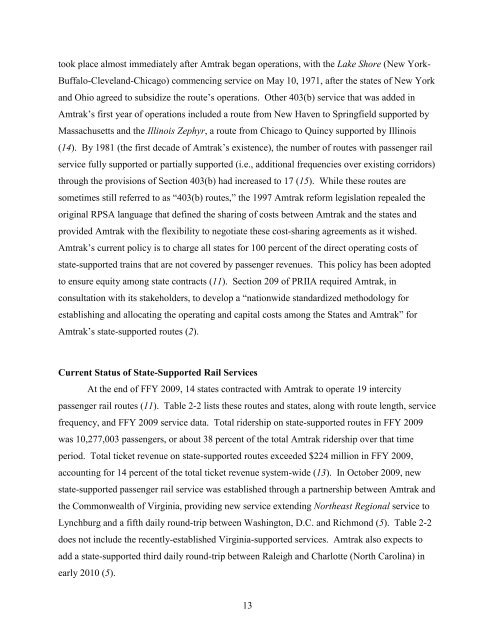Measuring the Benefits of Intercity Passenger Rail: A Study
Measuring the Benefits of Intercity Passenger Rail: A Study
Measuring the Benefits of Intercity Passenger Rail: A Study
You also want an ePaper? Increase the reach of your titles
YUMPU automatically turns print PDFs into web optimized ePapers that Google loves.
took place almost immediately after Amtrak began operations, with <strong>the</strong> Lake Shore (New York-<br />
Buffalo-Cleveland-Chicago) commencing service on May 10, 1971, after <strong>the</strong> states <strong>of</strong> New York<br />
and Ohio agreed to subsidize <strong>the</strong> route’s operations. O<strong>the</strong>r 403(b) service that was added in<br />
Amtrak’s first year <strong>of</strong> operations included a route from New Haven to Springfield supported by<br />
Massachusetts and <strong>the</strong> Illinois Zephyr, a route from Chicago to Quincy supported by Illinois<br />
(14). By 1981 (<strong>the</strong> first decade <strong>of</strong> Amtrak’s existence), <strong>the</strong> number <strong>of</strong> routes with passenger rail<br />
service fully supported or partially supported (i.e., additional frequencies over existing corridors)<br />
through <strong>the</strong> provisions <strong>of</strong> Section 403(b) had increased to 17 (15). While <strong>the</strong>se routes are<br />
sometimes still referred to as “403(b) routes,” <strong>the</strong> 1997 Amtrak reform legislation repealed <strong>the</strong><br />
original RPSA language that defined <strong>the</strong> sharing <strong>of</strong> costs between Amtrak and <strong>the</strong> states and<br />
provided Amtrak with <strong>the</strong> flexibility to negotiate <strong>the</strong>se cost-sharing agreements as it wished.<br />
Amtrak’s current policy is to charge all states for 100 percent <strong>of</strong> <strong>the</strong> direct operating costs <strong>of</strong><br />
state-supported trains that are not covered by passenger revenues. This policy has been adopted<br />
to ensure equity among state contracts (11). Section 209 <strong>of</strong> PRIIA required Amtrak, in<br />
consultation with its stakeholders, to develop a “nationwide standardized methodology for<br />
establishing and allocating <strong>the</strong> operating and capital costs among <strong>the</strong> States and Amtrak” for<br />
Amtrak’s state-supported routes (2).<br />
Current Status <strong>of</strong> State-Supported <strong>Rail</strong> Services<br />
At <strong>the</strong> end <strong>of</strong> FFY 2009, 14 states contracted with Amtrak to operate 19 intercity<br />
passenger rail routes (11). Table 2-2 lists <strong>the</strong>se routes and states, along with route length, service<br />
frequency, and FFY 2009 service data. Total ridership on state-supported routes in FFY 2009<br />
was 10,277,003 passengers, or about 38 percent <strong>of</strong> <strong>the</strong> total Amtrak ridership over that time<br />
period. Total ticket revenue on state-supported routes exceeded $224 million in FFY 2009,<br />
accounting for 14 percent <strong>of</strong> <strong>the</strong> total ticket revenue system-wide (13). In October 2009, new<br />
state-supported passenger rail service was established through a partnership between Amtrak and<br />
<strong>the</strong> Commonwealth <strong>of</strong> Virginia, providing new service extending Nor<strong>the</strong>ast Regional service to<br />
Lynchburg and a fifth daily round-trip between Washington, D.C. and Richmond (5). Table 2-2<br />
does not include <strong>the</strong> recently-established Virginia-supported services. Amtrak also expects to<br />
add a state-supported third daily round-trip between Raleigh and Charlotte (North Carolina) in<br />
early 2010 (5).<br />
13
















